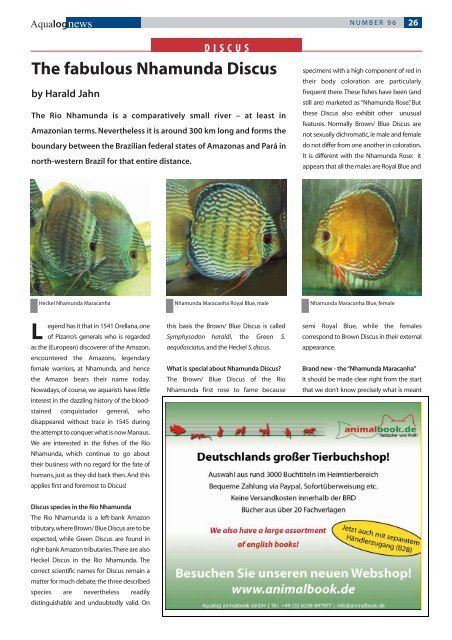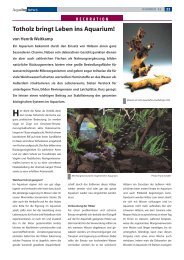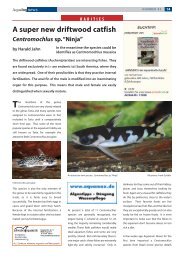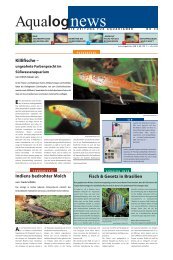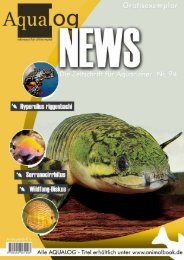Moenkhausia cosmops - Aqualog
Moenkhausia cosmops - Aqualog
Moenkhausia cosmops - Aqualog
Create successful ePaper yourself
Turn your PDF publications into a flip-book with our unique Google optimized e-Paper software.
<strong>Aqualog</strong>news NUMBER 96 26<br />
DISCUS<br />
The fabulous Nhamunda Discus<br />
by Harald Jahn<br />
The Rio Nhamunda is a comparatively small river – at least in<br />
Amazonian terms. Nevertheless it is around 300 km long and forms the<br />
boundary between the Brazilian federal states of Amazonas and Pará in<br />
north-western Brazil for that entire distance.<br />
L<br />
egend has it that in 1541 Orellana,one<br />
of Pizarro’s generals who is regarded<br />
as the (European) discoverer of the Amazon,<br />
encountered the Amazons, legendary<br />
female warriors, at Nhamunda, and hence<br />
the Amazon bears their name today.<br />
Nowadays, of course, we aquarists have little<br />
interest in the dazzling history of the bloodstained<br />
conquistador general, who<br />
disappeared without trace in 1545 during<br />
the attempt to conquer what is now Manaus.<br />
We are interested in the fishes of the Rio<br />
Nhamunda, which continue to go about<br />
their business with no regard for the fate of<br />
humans, just as they did back then. And this<br />
applies first and foremost to Discus!<br />
Discus species in the Rio Nhamunda<br />
The Rio Nhamunda is a left-bank Amazon<br />
tributary,where Brown/ Blue Discus are to be<br />
expected, while Green Discus are found in<br />
right-bank Amazon tributaries.There are also<br />
Heckel Discus in the Rio Nhamunda. The<br />
correct scientific names for Discus remain a<br />
matter for much debate; the three described<br />
species are nevertheless readily<br />
distinguishable and undoubtedly valid. On<br />
this basis the Brown/ Blue Discus is called<br />
Symphysodon haraldi, the Green S.<br />
aequifasciatus,and the Heckel S. discus.<br />
What is special about Nhamunda Discus?<br />
The Brown/ Blue Discus of the Rio<br />
Nhamunda first rose to fame because<br />
specimens with a high component of red in<br />
their body coloration are particularly<br />
frequent there. These fishes have been (and<br />
still are) marketed as “Nhamunda Rose”.But<br />
these Discus also exhibit other unusual<br />
features. Normally Brown/ Blue Discus are<br />
not sexually dichromatic, ie male and female<br />
do not differ from one another in coloration.<br />
It is different with the Nhamunda Rose: it<br />
appears that all the males are Royal Blue and<br />
Heckel Nhamunda Maracanha Nhamunda Maracanha Royal Blue, male Nhamunda Maracanha Blue, female<br />
semi Royal Blue, while the females<br />
correspond to Brown Discus in their external<br />
appearance.<br />
Brand new - the “Nhamunda Maracanha”<br />
It should be made clear right from the start<br />
that we don’t know precisely what is meant


